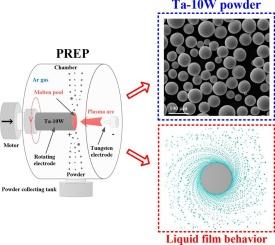Preparation of refractory Ta-10 W alloy powder by plasma rotating electrode process
IF 4.6
2区 材料科学
Q2 MATERIALS SCIENCE, MULTIDISCIPLINARY
International Journal of Refractory Metals & Hard Materials
Pub Date : 2025-08-24
DOI:10.1016/j.ijrmhm.2025.107398
引用次数: 0
Abstract
How to prepare high-performance and fine powder suitable for additive manufacturing (AM) is crucial to the deep utilization of Ta-10 W alloy. In this paper, refractory Ta-10 W alloy powder was prepared via the plasma rotating electrode process (PREP) technology, and the atomization process was numerically reconstructed using the computational fluid dynamics (CFD) method. Comprehensive characterization of the powder properties was performed. And the influences of key operating parameters on the size and properties of Ta-10 W alloy powder were systematically analyzed. Mechanism insights into parameter effects on atomization behavior and resultant powder properties were elucidated. Results demonstrate that high-performance Ta-10 W alloy powder with high sphericity, good surface quality, low oxygen content, freedom from hollow spheres and fine powder size suitable for additive manufacturing is successfully prepared. When the rotating speed increases from 21,000 rpm to 25,000 rpm or the current decreases from 2600 A to 2200 A, the size of the Ta-10 W alloy powder decreases. The liquid film disintegration mode during the atomization process is mainly liquid ligament disintegration. Increasing the rotating speed and decreasing the current will lead to a decrease in the thickness of the liquid film and the diameter of the liquid ligament, thereby reducing particle size. A high rotating speed, i.e., 25,000 rpm and a low current, i.e., 2200 A can be employed to obtain Ta-10 W alloy powder with a small size.

等离子体旋转电极法制备难熔ta - 10w合金粉末
如何制备适合增材制造(AM)的高性能细粉末是ta - 10w合金深度利用的关键。本文采用等离子体旋转电极工艺(PREP)制备了难熔ta - 10w合金粉末,并利用计算流体力学(CFD)方法对雾化过程进行了数值模拟。对粉体性能进行了综合表征。系统分析了关键操作参数对ta - 10w合金粉末尺寸和性能的影响。阐明了参数对雾化行为和粉末性能影响的机理。结果表明,成功制备了球形度高、表面质量好、氧含量低、无空心球、粉末粒度细、适合增材制造的高性能ta - 10w合金粉末。当转速从21,000 rpm增加到25,000 rpm或电流从2600 A减小到2200 A时,ta - 10w合金粉末的尺寸减小。雾化过程中液膜的崩解方式主要为液韧带崩解。提高转速,减小电流,会使液膜厚度和液韧带直径减小,从而减小粒径。采用高转速(25000转/分)和低电流(2200 A)可以获得小尺寸的ta - 10w合金粉末。
本文章由计算机程序翻译,如有差异,请以英文原文为准。
求助全文
约1分钟内获得全文
求助全文
来源期刊
CiteScore
7.00
自引率
13.90%
发文量
236
审稿时长
35 days
期刊介绍:
The International Journal of Refractory Metals and Hard Materials (IJRMHM) publishes original research articles concerned with all aspects of refractory metals and hard materials. Refractory metals are defined as metals with melting points higher than 1800 °C. These are tungsten, molybdenum, chromium, tantalum, niobium, hafnium, and rhenium, as well as many compounds and alloys based thereupon. Hard materials that are included in the scope of this journal are defined as materials with hardness values higher than 1000 kg/mm2, primarily intended for applications as manufacturing tools or wear resistant components in mechanical systems. Thus they encompass carbides, nitrides and borides of metals, and related compounds. A special focus of this journal is put on the family of hardmetals, which is also known as cemented tungsten carbide, and cermets which are based on titanium carbide and carbonitrides with or without a metal binder. Ceramics and superhard materials including diamond and cubic boron nitride may also be accepted provided the subject material is presented as hard materials as defined above.

 求助内容:
求助内容: 应助结果提醒方式:
应助结果提醒方式:


